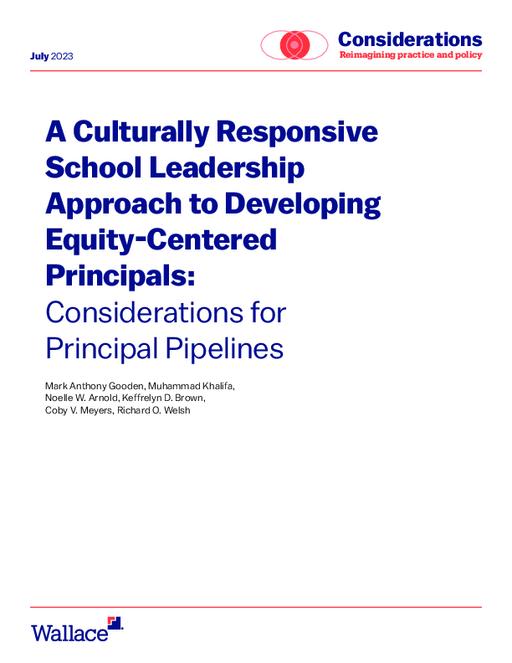- Author(s)
- Mark Anthony Gooden, Muhammad Khalifa, Noelle W. Arnold, Keffrelyn D. Brown, Coby V. Meyers, and Richard O. Welsh
- Publisher(s)
- The Wallace Foundation
Research Approach
The paper is based on a review of education literature and draws in large part from the influential Culturally Responsive School Leadership framework, which was developed by three education scholars, including two of the paper's authors.
From 2011 to 2017, The Wallace Foundation funded a major initiative that supported six large school districts to develop “comprehensive, aligned principal pipelines”—“comprehensive” because they covered a full spectrum of district activities to boost school leadership; “aligned” because these activities served to reinforce one another. Extensive research on this initiative identified seven areas, or “domains,” of activity involved in building these pipelines. These domains range from development of leader standards to use of leader tracking systems that can help district officials make informed decisions about career pathways for school leaders, both potential and sitting. Research found that instituting this systematic approach led to significant benefits for student achievement, according to a comparison of schools in pipeline districts with schools in non-pipeline districts in the same state (Gates et al., 2019).
For this report, the authors reviewed the educational equity literature underpinning CRSL to identify how each of the seven domains could be redesigned with a goal of preparing and supporting equity-centered school leaders.
Some domains (such as principal preparation and leader standards) have robust research to support recommendations for specific actions. In others (such as leader tracking systems and principal supervisors), the research is less robust but provides a sufficient basis for authors to surmise how these domains might use a CRSL lens to help produce equity-centered leaders.
The equity-focused research cited in this paper was identified through a review of literature in education leadership, which positioned equity as part of a theoretical construct to be better understood (e.g., Brown, 2004; Shields, 2010; Theoharis, 2009) as an outcome to be pursued (e.g., Santamaría, 2014; Skrla et al., 2004) or as a set of lessons to be applied (Galloway & Ishimaru, 2015; Khalifa, 2018; Pazey & Cole, 2013). These three related areas of mostly qualitative research suggest that how equity is defined and framed for education leaders can be widely encompassing. However, common elements imply equity-centered leadership contains a critique of oppressive practice (Khalifa, 2018), a commitment to fairness (Gooden, 2014; Green, 2017), and an understanding of community and the knowledge within it (Ishimaru, 2020).

